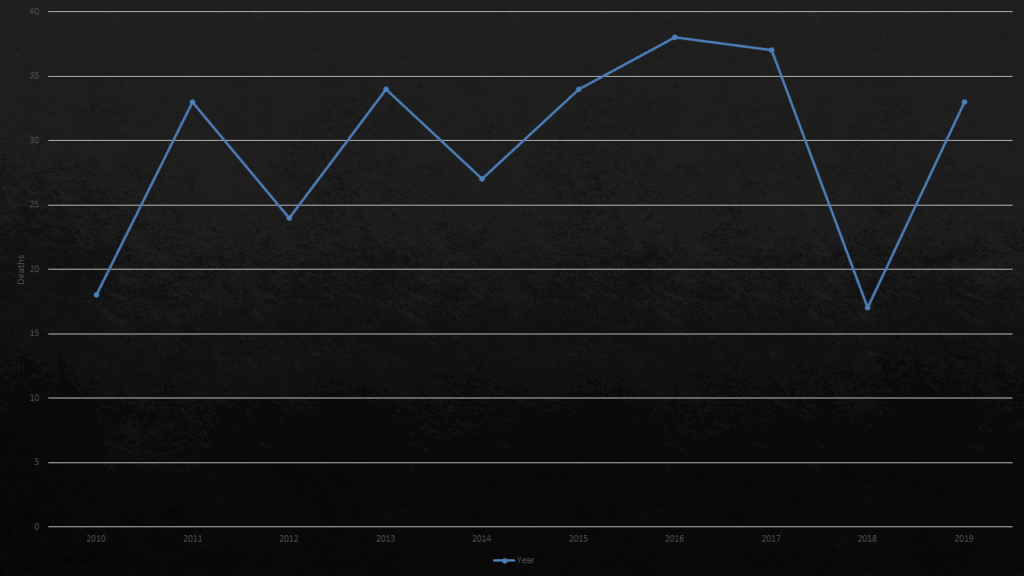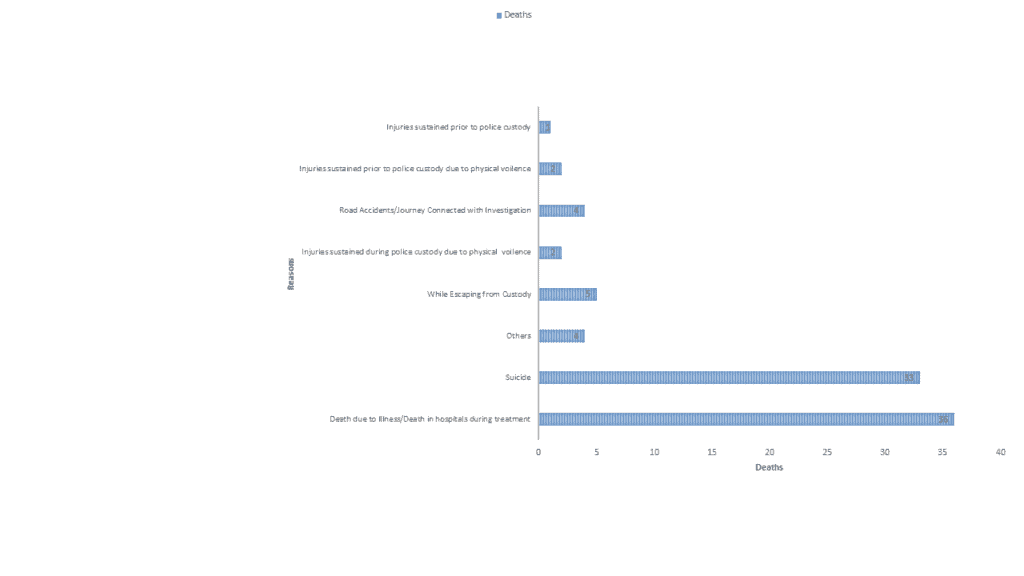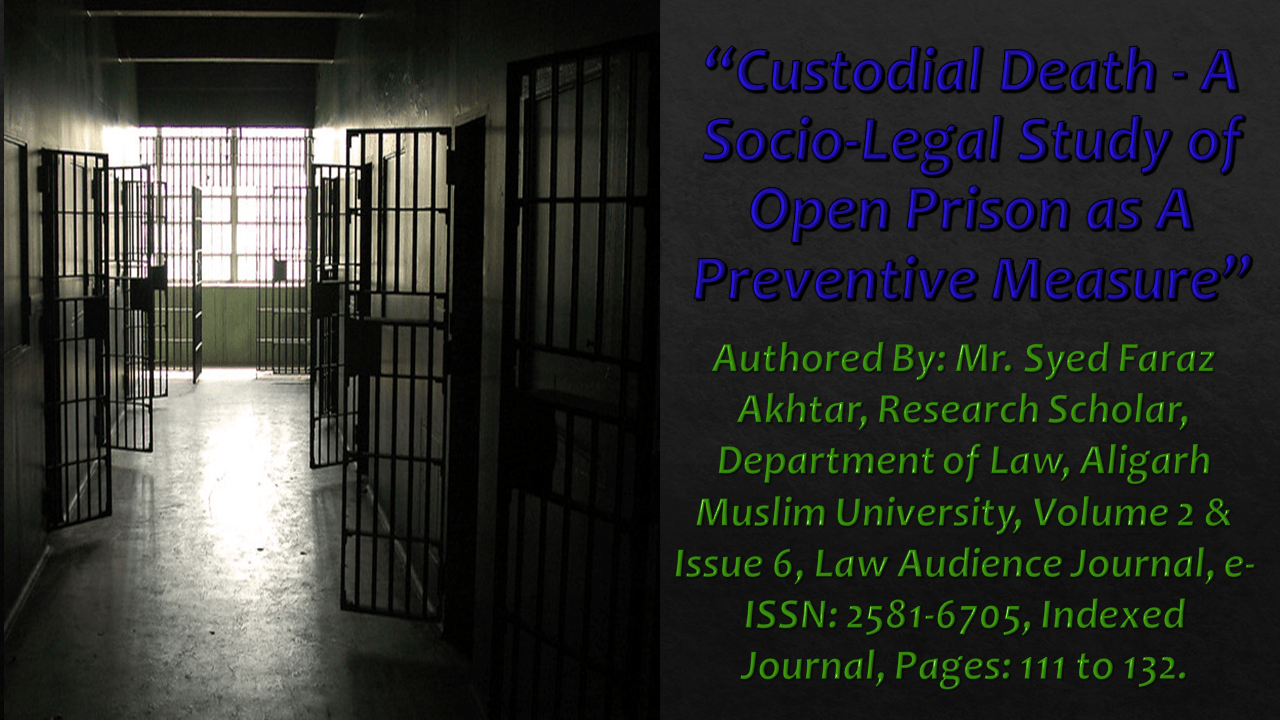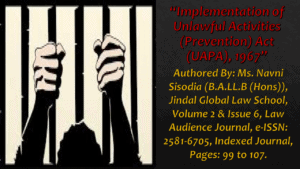Click here to download the full paper (PDF)
Authored By: Mr. Syed Faraz Akhtar, Research Scholar, Department of Law, Aligarh Muslim University,
Click here for Copyright Policy.
ABSTRACT:
“Custodial torture, regardless of gender, age, or health status, is almost an international procedure. Third World countries, such as India, this worst type of violation of human rights has become a severe and alarming problem. Brutal atrocities perpetuated on suspects/convicted persons and prisoners by police, and other law enforcement agencies have risen recently. Custodial torment has now become so routine that the administration not only underestimates it as a standard cross-examine policing procedure but also as a police system. The result is that the changes to this absurd lead just astonish the public at large. There is open chaos when something horrible happens. The administration pays attention to the custodial torment at exactly that moment, as the open objection leaves them without any alternative. This paper explores the growing “social evil-custodial death” in India by analyzing the evidence and recent unfortunate events. The overarching objective of the research is to demonstrate how custodial deaths can be removed from society. The Supreme Court recommended that ‘open prisons’ be set up to reduce deaths in custody. The main aims of open prisons are to minimize overcrowding in prisons, reward good behavior, free education, prevent discontent, build long-term hope, give training for agriculture and industry in order to prevent deaths from custody”.
Keywords: Custodial Death, Open Prison, Social Justice, Fundamental Rights, Human Rights, Judiciary, Social, Legal.
1. INTRODUCTION:
For a long time, torture and detention abuse by the police have been a major concern. In several parts of the globe and India, the number of such accidents has risen over the years. The police use third-degree approaches to extract faiths and declarations from the accused. That is a reality. Such approaches also lead to severe wounds and even death. It is also a reality that victims are pressurized to commit suicide because they cannot tolerate such torture and humiliation. Following the murder of George Floyd in the United States and the custody of J. Bennicks and P. Jayaraj in Tamil Nadu, India, the problem, and the demands for reforms of the police have been wrought and the guilty officers have been held responsible for their misdeeds. In the IPC there are some solutions to this issue. The Supreme Court of India also, periodically, has given the Central and state governments directions and orders to take the matter seriously, introduce ways of bringing down cases of imprisonment, and punishing truant officials. However, these did not produce results, as can be seen from the increasing numbers of deaths in custody in the world. Interestingly speaking, India has no anti-torture statute, and this issue is once again being heatedly discussed.
1.1 WHAT IS CUSTODIAL DEATH:
Deaths in custody are the deaths of people who are arrested by police before or after pretrial. Deaths under custody can be widely grouped into three categories:
- Death in police custody.
- Death in judicial custody; and
- Death in custody of army or paramilitary force.
Death in custody is commonly pointed to as death in a person who is being tried or convicted of an offence. It may be due to, natural causes such as disease, or even due to suicide, prisoners’ struggles, but police torture and brutality are the reasons behind death in many cases. The problem is highly contentious and complex. Victims are also tortured before their arrest, e.g., before their detention, which assists authorities with the argument that these are not custodial assault cases and that injuries have occurred before their arrest. Often, before the arrest, fake experiences kill victims. This is also a kind of death in custody that is difficult to prove. The most fascinating part is that there is not any documentation or reports with the police. This makes it difficult to recognize custodial abuse and subsequent deaths.
Custodial deaths are one of the top examples of human rights violations. The Indian Constitution guarantees an unambiguous assault on the right to life and freedom. The relevant states are responsible for protecting the lives of the defendants and convicts. Persons charged or charged with crimes have the right to a fair trial, protection, and safety in police, judicial and correctional homes. But law enforcement officers also fail miserably as they discharge their statutory duty and even more disappointing is the fact that the offenders have made a complete attempt to hide their wrongdoings after these events happen. In shielding the accused policemen, the Government performs a significant role.[1] “Custodial crimes and torture of persons in police custody are heinous and revolting as they reflect a betrayal of custodial trust by the public authority against defenseless citizen, such practices violate fundamental and human rights”[2].
It has acknowledged the value of human rights case law. Human rights are the rights of the individual once born and universally identical and able to be exercised by all. Regardless of color, sex, the rights of all citizens are beyond the prejudice of any sort. India is punishable for persons who violate civil and human rights. This Act must uphold the common man’s confidence in their rights and, if they are deprived of this essential right, to provide the appropriate remedy. Responsibility comes with authority, which degrades the confidence in authorities and the trust in humanity in this system when exploited by the law custodians.
Torture victims may suffer severe and long-term effects, such as physical damage, chronic pain, ill health, mental health, and conduct consequences such as substance dependence, solitude, guilt, and isolation. Article 21 that no person must experience the difficulty of life or individual freedom apart from an understanding of the strategy set up by legislation is described by the Indian Constitution of 1950. It also includes rights such as safety, loneliness, custodial abuse, and the right to protection. It is one of the awful offences.
A two-word guard and provocation combination can accomplish that. Custody means supervision. Even if detention follows the custody, there are no signs of malady during custody. In other words, if an individual is being held in legal custody and tortured, violated, killed, and other horrific acts against his desire. As a result of the rapid prison deaths in judicial custody, the very belief in the government of our country has been shaken. The most affectionate people in detention are those from the lower and poorer strata. The primordial position is given by the Indian Constitution in Article 21 clearly shows that personal life and freedom in the civilized society are the most important characteristics, and consequently, the breach and absence of individual liberty and the risk of State action to live in the most civilized societies are considered a serious resort of the state enforcement authority, for freedom of freedom, is invaluable.
The existing processes for monitoring judicial authorities’ acts must therefore be strengthened. Other than that, in a democratic nation like India, the police or judiciary authorities are supreme as power is granted by a social contract. Police function as a government agent who eventually bears the responsibility to people. They are responsible for protecting the planet from murderers, thefts, terrorists, and jihadists to make them a safe place to live.
Dignity and security are the foundation of any kind of social system between the State and its people. Therefore, the duty of the State is every person and its honor. In common reasons for death under judicial or police custody include overloading inmates, not well-nourished food, no sanitary facilities, and lack of health aid, while custodianship is one of the best-recognized causes of death under locks.
Every country has drafted various kinds of legislation in the fight against custodial torture, however, while it is in any way prohibited, it is one of the most dishonored human rights even after conferences and committees to dissuade custodial torture. While there are quite common crimes against inmates and prisoners, little is only disclosed and the individual responsible is punished. There are several reasons why an individual is faced with abuse in custody but mostly for extracting information from him. There are instances in which the accused person is tortured in varying degrees and deaths in custody. (D. Sharma and R. Thakur, 2020)[3].
2. BACKGROUND OF THE STUDY:
The prison system is over 100 years old in our country. Looking back, the enormous modifications made during this period may not be cognizable. The invention stops only used in some prisons and not everywhere in the world and to promise the criminal treatment scheme. A lot is gone now brutal treatment approaches that give rise to various new methods like outdoor work, higher education, leisure facilities and correction schemes, workgroup, and wage payment. There are now attempts to be done under less oppressive discipline and to handle inmates with greater freedom. (1970)[4] Intense discussion and sharp criticism in numerous public forums are the administration of the prisons and prisoners reform. In recent years, India’s Honorable Supreme Court has been serious on prison’s inhumane and degrading conditions.
The issues in many countries such as dilapidated jail system, overpopulation, and congestion, the proportion of prisoners on trial, insufficient jail personnel, insufficient properly prisoners care and treatment, etc., are taken care of by the social activists and the press. With an increasing commitment to defense the distress of the prisoners in the different walks of life, a critical public policy concern arose. (Government of India, Report , 2004)[5]. Over the last 10 years, in the National Crime Records Bureau (NCRB) data, the majority (69 percent) of 1,004 deaths in police custody have been caused either by disease and natural causes (40 percent) or by suspected suicide (29 percent). In the last 10 years, more suicide deaths in custody by police were recorded, 36 percent of them in 2015-2019 as suicides.
However, families in some cases have suspected foul play or suicides as a result of abuse in custody. Only from 2014, and in only 6% of cases, physical attacks by the police were reported. In 2019, the police attack in that year was the result of just 2.4 percent of 85 deaths in police custody. However, the NGO project National Campaign Against Torture attributed torture or foul-playing 76 percent of its 124 deaths in police custody reported the same year. In the last 10 years, the number of “hospitalization/disease/natural deaths” has been about 403 out of 1,004 deaths (40 percent) in Police Custody – as a majority[6].

Source Crime in India reports 2010-19, National Crime Records Bureau[7]
Figure 1 Reasons assigned for death of persons in police custody, 2010-19
Over the last decade, Crime in India has registered more suicidal deaths in police custody. 159 out of 444 police custody deaths (36 percent) over the past five years (2015-19), compared to 136 out of 560 deaths (24 percent) in 2010-14, were recorded as suicides.

Source: Crime in India reports 2010-19, National Crime Records Bureau[8]
Figure 2. Deaths by Suicide in Police Custody, 2010-19
In 2019, 81% of the reasons recorded were either death from suicide (39%) or hospital disease/ death (42%) during treatment. Gujarat (5), Maharashtra (7), and Tamil Nadu (10) accounted for more than 60 percent of 36 police custodial deaths recorded in 2019 as a result of diseases or hospitals[9].

Source: Crime in India reports 2010-19, National Crime Records Bureau[10]
Figure 3 Reasons assigned for death of persons in police custody, 2019.
3. LEGAL AND POLICY FRAMEWORK:
There are diverse legislative and policy systems concerning deaths after imprisonment and police detention. Finally, emphasize is that even from the legislative and policy contexts, unnatural deaths are apparent. It is difficult to define and far less clarified after custody inquiry, reporting, and responsibilities[11].
3.1 THE PRISON AND PROBATION OMBUDSMAN (PPO):
The PPO conducts an inquiry into all fatalities of inmates, juveniles in custody, residents of licensed premises, and migrant prisoners for every reason. The commission has the discretion to study death of inmates or captives newly released. The PPO, partially because of its unusual notification of such a death, is not investigated. Since the services are lacking, too.
The objective of the proceedings of the Ombudsman is:
- To identify circumstances and death events, particularly about the management of the person by the competent authority, but also the relevant external factors
- To investigate whether any reform in processes, policies, procedure, or management can avoid a recurrence.
- To investigate relevant health problems and evaluate clinical treatment, where applicable, by NHS
- To provide the bereaved relatives with explanations and insight, and
- To support the Coroner’s inquiry in fulfilling the investigative duty under Article 2 of the European Convention on Human Rights (‘The right to life’), by providing for full disclosure of facts and any relevant facts as far as is possible. Failure to expose and identify any praiseworthy actions or practices and learnings are derived from death.
3.2 PREVENTING, REPORTING, AND INVESTIGATING DEATHS THAT OCCUR FOLLOWING POLICE CUSTODY:
Information on how to avoid the deaths of prisoners is provided by the College of Policing’s Detention and Custody Authorized Professional Practice (APP). Although the APP is not an official and up-to-date instrument, it is police practice source. There are two related parts of the APP. The first involves custodial deaths, including medical intervention during a large custody event, and the information and investigation provisions of the IPCC. The second section, in particular, is covered by Section 4 ‘Release from custody.’ A pre-release risk evaluation should be conducted in the APP document. The document emphasizes that it should be an important part of a continuing risk before release assessment during the detention period: the custody officer till the release point. It should instead be a continuous operation arrest and closure at release stage.
The APP policy proposes to allow custody officers to refer prisoners to local facilities, such as social services, health, and hostels/refugees. It says that custody officers should have access to the referral available to the police departments and written material that can assist a detained person to refer to agencies. Particularly, it states that ‘the responsibility of compel custody leads to strategic connections with allies to ensure there are sufficient choices for local service.’ Apart from relating to prisoners or to provide information about potential self-reference to the related services, officers in custody can also set up terms of bail to secure the prisoner’s safety. If the prisoner is convicted, he/she can be kept under Sec. 38 of Police and Criminal Evidence Act (PACE) 1984 if there is fair justification for the consider that his/her defense requires the detention.
Whether the prisoner did not custody officers may also use a variety of authorizations, including Article 136 of this Act. Act 1983 on mental health, section 4B and 5 of the Act 2005 on mental capacity or a police force security order by Article 46 of the Children’s Act 1989 (in cases of children). Also, one of the responsibilities under the College of Police (2015) is specified ‘to take feasible operational actions is the European Convention on Human Rights to avoid the actual or imminent risk of death. (within the legal authority of the officer) Which is known or should have been known to the officer. There is therefore authority a location that the police can use to deter a person at risk without sufficient support from dying in society. Police detention protocols for examining a death are relatively simple. When death happens, the professional standards of the local authorities, the IPCC is immediately notified by the Professional Standards Department (PSD). The IPCC then considers the case circumstances. It determines whether an inquiry is needed and so, whether the IPCC or the local policeman who can investigate, the IPCC will, however, be monitored or regulated.
Where does the IPCC the suitable authority shall address the suggestions following an investigation and where it does not follow such suggestions, what actions, and the reason for those decisions it would take as a result. If the death occurs after contact with the police, direct or indirect, and an explanation of the causal connection is given, reference must be made to the IPCC.
Also, the IPCC informs that all obvious suicides within two days of contact with the police should occur be related to themselves. The specialist when a death happens the PSD must notify IPCC ‘without delay and in all circumstances not later than the close of the day after the first day of the debate the required authorities focus (Police) (Complaints and Misconduct) 2012). The number of these deaths is, however, difficult to understand and making judgments and learning from several deaths of potential factors.
Finally, an apparent local police department cannot be alerted. The parameters for such decisions “might vary over time, e.g., in reaction to present public and community issues, which would suggest that an examination of the pattern would not be significant.” suicides, thereby being unable to establish a connection between the policing and death. That said, the IPCC publishes annual data on the numbers and specifics of all apparent suicides within two days from the detention of the police.
3.3 CORONERS’ REPORTS TO PREVENT FUTURE DEATHS:
The Coroners and Justice Act 2009 significantly amended the laws on coroners’ inquiries. If a death takes place in detention, the investigation is often carried out by a jury. A jury inquiry is less likely to pass after custody, but the death is even less likely be investigated. Where the coroner feels measures should be taken to avoid these future fatalities, he or she is obliged to report to a person, an organization, the department or corporation of local authorities or governments. This legal obligation is strengthened earlier position on the production of reports by coroners (which is called Rule 43 reports). Alone last year, 504 Future Death Reports were prepared and since 25 July 2013, more than 1,000 reports have been posted to the Internet. 71 of these are mentioned in the heading ‘deaths in connection with state custody.’[12]
Both of them seem to refer to custody deaths (choices of the ‘linked’ deaths title custody is interesting) and the Chief Coroner revealed no further informal exploration more pertinent to this analysis are other findings. In his 2014-15 annual report, the Chief Coroner stated: Coroners have no privilege to support them in this role, as in many areas of the world of common law[13].
Therefore, the legislation allows coroners to make general recommendations, for example, ‘I suggest you review this procedure’ or ‘this policy’ but not “I advise you to change your policy from X to Y.” However, coroner reports are an important method in preventing the future deaths and the daily release of public judicial reports. The website recalls the value of this work of the public intentionally. Some reports are chosen by the Chief Coroner. Examples in the last year like ambulance attendance times, detention deaths, and deaths of the kids. Additional research should investigate whether these reports, in addition to or alongside PPO reports, are a ‘useful tool.’ The study has informally found that coroners who lack treatment and support are genuinely concerned for custody-free individuals who commit suicide. More analysis may be possible, try to ascertain, for example, whether questions posed in the reports of coroners have been addressed. This will show whether or not the same problems occur periodically. (J. Phillips et. al., 2016)[14].
3.4 THE PROVISIONS UNDER THE CONSTITUTION OF INDIA REGARDING CUSTODIAL DEATH:
Police custody death is among the worst crimes in a civilized, state-ruled country, and a major challenge to a civil society that is orderly. Custodial torture violates citizens’ fundamental rights and is an offence to human dignity. The depth and breadth of Article 21 of the Constitution are kept in Bhajan Kaurv. Delhi Administration using the Lt. Governor of the Delhi, Supreme Court: The working of our democracy is based on personal freedom. If the State government does not take appropriate steps to ensure enforcement, the lofty object of Constitutional Article 21 will be denied. The State must monitor and curb the fidelity of those who risk other people’s lives and freedom. The state must ensure that people are regarded as human beings and live and act in the same way.
Constitutional Article 21 is a major symbol of freedom and its aim should be to ensure equality, human survival, and human growth. So that Constitutional Article 21 is fully protected and achieved, the State needs to seek to give its citizens a new vision and a peaceful future, in which they will collaborate, coordinate, and coexist. Art 21 is not a “simple platitude” or a dead, dormant text. Dissipated, inert, and decomposed. It is a pulsating reality that brings life and a spirit of freedom to everyone within the country, and that must be made possible to reach everyone. It is the State’s responsibility and obligation to implement law and order and to preserve public order for all sections of society, regardless of their caste, faith, religion, color, area, or language to benefit from the fruits of democracy. Also, Constitutional Article 38 calls upon the State to foster welfare by securing and safeguarding the socio-economic, social, and political order in which justice informs all national institutions. These are the constitutional objectives, and how these objectives are to be achieved are Art 21 and other fundamental rights. (2020)[15].
4. OPEN PRISONS AS A PREVENTIVE MEASURE FOR CUSTODIAL DEATH:
Various aspects go together with the creation of a prison. This is not defined as an open prison but is generally known as a place in which prisoners have comparative freedom, minimum safety, and self-rehabilitation.” Unlike regulated jails, there is relatively less strict legislation for open prisoners. They are titled after many things, such as a minimum safety prison, open-air camps, or a wall-free prison. The basic principle of an open prison is that inmates have a limited degree of security and self-control. Some inmates need to be handled carefully, as inmates or suspects always seek to improve overall. Open jail is an acknowledgment of his distress and gives prisoners the chance to go back to mainstream society. (Ratliff, 1999)[16].
Death sentenced prisoners and only prisoners of good behavior are selected and sent to these prisons for success and contribution to rehabilitation and recovery. In several regions of India, various open-prison steps have been taken. “These jails are not prison yet” was the intention of the open prisons. The company is in the custody of a free mind and body. This helps re-emerge the dignity of the individual and allows the individual a sense of self-confidence, self-respect, and a sense of responsibility to eliminate crime. As a result, crime and not the perpetrator are excluded. In several Indian states, there are similar open prisons. (J. G. Murphy, 1992)[17].
The main objectives of creating open jails are to reduce prison overcrowding, reward good behavior, free training, quality stable public service staff, prevent discontent, create long-term hope, provide training in agriculture and industry, examine how good prisoners are released, and enable prisoners to live (in some states). (S. Ghosh, 1993)[18].
Here are some of the advantages of open prisons to limit custodial deaths in India:
- The effects of the crime on the inmate are minimized in open prisons.
- It diminishes the congestion in jails and keeps prison humanitarian life alive.
- It is less expensive and simpler than keeping prisoners in state jails.
- It helps to restore dignity and gives a sense of independence, respect for self, confidence, and transparency. For everybody, this is important. It helps raise individual social awareness and moral awareness and end crime.
- The institutionalization and criminalization of open prisons are less likely. The open prison regime is less stereotypical and more natural. Social learning is an inevitable experience.
- Open prisons are also a chance for full interaction with both prisoners and society as prisoners go to work, pray and play.
- It is less expensive to operate an open-air prison with equivalent numbers than an enclosed prison. There is the unnecessary expense of constructing or maintaining a fenced building.
- The open prison would help many people with little technical knowledge to operate, but who cannot absorb this technical know-how in industry or factories.
- The benefits of its work – like fresh vegetables, cereal and pulse crops, processing of oil, eggs, meat, and other products – are enjoyed in the open prison with big farms.
- It gives prisoners self-respect, discipline, a sense of dignity, and self-control the main thing about a free jail.
- Free and safe access to air for prisoners in open prisons is no less important.
- Moreover, better benefits, i.e., speech services, higher remission rates, better wages as well as family visits, can also be achieved. (P. Chandra, 1984)[19].
5. RELATED RESEARCH:
Alison Liebling (2017), life can end in jail in many ways. This study considers suicides, murders, and the entire lifetime sentence as three causes of unnatural death, which demonstrate the essential characteristics of jail experience in this environment and take on a special significance. These ways of custody death question “the legitimate intent of detention.” This account informs reflections on the value of hope and integrity in jail. (A. Liebling, 2017)[20].
Stephane M Shepherd et al. (2018), among the Indigenous Australians, has documented a high rate of suicidal behavior. The probability of suicidal behavior of persons associated with the law is also higher. In this study, 107 native adult males in jail in Victoria, Australia tried to assess the frequency and correlating suicidal behaviors. A formal interview with the psychological evaluation was conducted by participants. Information has been provided on suicidal behavior, social and demographics, environmental stresses, stressful incidents in life, and mental health. A high percentage of Indigenous men under custody had life-length suicidal ideations (63.7%), and over half had suicidal attempts (54.5 percent).
In the last 12 months, smaller yet large numbers of participants had an idea (27.9 percent). A loved one passed away in the last 12 months expected that the latest idea was a life-long effort at suicide, along with a diagnosis of post-traumatic anxiety disorder. There is a surprisingly high rate of suicide among indigenous peoples in detention. Correlations of suicidal behaviors, which indicates immediate public health responses, for native people in detention in this report. In communities at risk for suicidal conduct, prevention must begin. To increase public awareness and to provide affordable and least restrictive care and treatment, low-intensity mental health services infrastructure is needed in communities. Custodial suicide management and prevention programs must also continue to be improved by prisons. (S.M. Shepherd at. el., 2018)[21]
Santosh Bhoi et al. (2018), a retrospective, autopsy-based deaths analysis from April 2005 to April 2017 for 12 years. A total of 22 cases, including 19 males and 3 females, have been analyzed. The age of cases ranges from 20 to 71 years, with a median age case of 30 to 39 years of age of 31.81%. There were eight deaths in the police lock-up, fifth in prison, eight in hospital and one in another. 11 cases of natural deaths have been reported, and 11 cases have been reported as unnatural, of which 31.81% are suicidal, 13.63% accidental, and 4.54% homicidal. The most popular cause of death in natural deaths was pulmonary TB and the most common cause was accidental death. (Bhoi at. el., 2018)[22].
D R Mittal et al. (2019), firstly, the human rights horizon is growing but the rate of crime is rising at the same time. Custodial deaths in this sense are amongst the most controversial deaths for forensic experts’ investigation. Sometimes these deaths invite mass rancor and criticism. It is not necessarily because of supernatural or violent causes, but rather because of natural causes, most of the time. Prospective research was carried out to analyze deaths in custody from all aspects. Over an analysis period of 2 years, a total of 135 (16 female and 119 male) custodial deaths were thoroughly investigated. In prison, 33 cases (24.45%) died in custody, and in two cases (1.48%) deaths occurring in police custody were recorded as 100 cases (74.07%) died in custody. In 92 cases (out of 135), death was natural 95.65%, while 4.35% were unnatural. Death was a natural cause of death. The most common natural cause of pulmonary tuberculosis among prison deaths was prison deaths (22.8%), n=16. The primary cause of natural death was coronary heart disease in mental hospitals (12.8 percent, n=9). As for unnatural deaths, two accidental and suicidal deaths (2.17 percent respectively) were reported in each case, and no homicidal deaths were reported.[23]
Dr. Gan Chee Keong et al. (2019), if attack and death in the custody have happened, and the facts indicate that police misconduct, wrongful use of authority, or neglect is responsible for assault or death, then family members shall be entitled to bring an assault and customs death suit against a police officer and the government. This article examines the initiation of the civil lawsuit resulting from attacks and deaths in custody, investigating the causes of action, liability assessments, government lawsuits, and court responses in this field.[24]
Audrey Roulston et al. (2020), populations of prisoners are increasing worldwide, with a rise in the number of elderly and infirm inmates and longer jail terms. This scoping study examined the death experiences of staff and family members in prisons. A technical quest followed Embase, Ovid MEDLINE, CINAHL, and PsycINFO. Empirical and non-empirical death tests were screened in prison custody. Arksey and O’Malley’s framework used data extraction to classify, analyze and report thematic analysis was supported by Braun and Clarke. 174 of 12,127 citations were chosen and 22 were contained in the final scope assessment.
Four themes were discovered through the thematic analysis:
- transformations,
- gaps in time,
- conflicts of interests, and
Prison personnel prevented their personal lives from being infected. Inaccurate and untimely details, inadequate restrictions, and poor communication have been distressing families. Staff also balanced humanitarian and security needs. Unmet need for advocacy, contact, and treatment, bad end-of-life, and sorrow could be enhanced with the training of employees and intervention in social activities. Personnel needs psychosocial assistance, oversight, and advice.[25]
Sharad V. Kuchewar et al. (2020), death linked to custody is a globally important human rights issue. In this vulnerable population, causes of death and related factors depend on country and area. In this study, the various causes and factors related to custody and the intervention areas for preventing custody deaths were analyzed. This retrospective research was carried out using custody files in Shri V. N. Government Medical College, Yavatmal, Maharashtra State (India). During the period 2000-2018, a total of 108 cases have been autopsied by the Department. For the extraction of data from records of such instances, the researchers used a prefabricated proforma; the data were tabulated and encoded and analyzed in detail. There was male dominance (105) and only three female cases were observed (Male: Female ratio 1:0.028). In police custody/action the most prevalent age group of deaths was 31-40 years, while in inmates, the age group was 41–50. The majority of death was natural (69.44%); 89.33% of these deaths were inmates, with the most common cardiac cause.
A lot of people were killed in the hospital for tertiary treatment because of their cardiac causes. Suicides have been a frequent source of unnatural fatalities among police prisoners. The number of casualties in police custody committed suicide after being suspended. All suicide cases were found in the police action by insecticide poisoning, and hanging has been the only cause of prison suicide. Injuries of blunt force are a common cause of police custody homicide due to the police’s use of force. The lack of awareness of the death causes and the irresponsible actions of the prisoners, the health and wellbeing of the prisoners are preventable factors for deaths due to custody.[26]
Sunday S Soyemi et al. (2021), The worldwide problem is deaths in custody. In developed countries, however, such knowledge is sometimes lacking. This study aimed to look at the cause, profile, and mode of death in Lagos State, Nigeria, in retrospect. An 11-year review was carried out of the Chief Medical Examiner’s office (June 2008-June 2019) on all autopsy events of custodial deaths. Data were retrieved from the documents, which comprised the variables of offence, age, sex, place of death, time of custody, and cause and death. From frequencies and percentages, the results were analyzed. 45 deaths in custody were reported out of 9894 autopsies during the study period. It was 84.4%, and 15.6%, of men and females (M: F = 5.4:1). respectively. Evolved between the ages of 20 and 64 years, the mean age was 37 ± 11.0. In the third decade, these deaths were the most frequent. The two main causes for arrest were financial crime and armed robbery while most deaths took place in detention 24 hours after the arrival. Active heart failure from hypertensive cardiac disease and craniocerebral damage from blunt-force trauma were the two major causes of death. Deaths in detention must be investigated properly and, if and when they occur, special focus must be placed on illegal deaths.[27]
6. CONCLUSION:
Belief in law has decreased because justice does not reach the individual and the necessary places. The long-term trial of justice leads to a long-term jail term for the convicted, while also increasing the likelihood of detention torture, and ultimately death in many cases. The atmosphere in jails is not suitable for inmates, it is an obstacle to a dignified prisoner. Police use intimidation or torture as quickly as possible to gather evidence from the defendant and to be relieved by making reasons that make it in our judicial system lacuna. The current police and police conduct system must be strengthened to avoid it.
The inmate continues to be a member of the penal system in the course of open jail institutional treatment, to build constructive thinking on citizens’ engagement in law. The emergence of an open prison marks the start of a new era of prison history. In the matter of constructing more open jails to improve prisoners and reduce custodial deaths, therefore, the prison administration and criminal justice system are relevant for this purpose.
Prisoners also advocate the protection of inmates in prisons, regardless of their state of health and their socio-economic status, for human rights and social justice, prison and end-of-life services have usually been underfunded, and the demand for it is strong.
The following improvements can be done in the prison system to address the unmet social needs of prisoners and families who expect to die in prison:
- Integrity, reverence, and consideration need to be viewed for both inmates and their families.
- Social workers from prisons should be empowered to identify needs for social care, to lobby and to provide resources for access to assistance, and to facilitate healing and contact between inmates, families, and victims’ groups.
- Prison workers should be properly educated to provide the family with “breaking bad news”.
- Training in promoting social and human rights is required for all employees.
- Early release plans should be checked and provided in cases of under-resourced or inaccessible prisons hospice care.
- Initiatives such as the ‘Custody Charter Dying Well’ are to be widely implemented.
- Corrections personnel need monitoring and self-care systems to deal with death in custody and investigations.
- The right of family visitors to end-of-life inmates should be more flexible.
- Families should be informed timely and accurately of deaths.
- Families should be given impartial counselling services.
Footnotes:
[1] Rangita Chowdhury, Custodial Death and Anti-Torture Law, available at https://blog.ipleaders.in/custodial-death-anti-torture-law/.
[2] 152nd Report on Custodial Crimes 1994, Law Commission of India, available at https://lawcommissionofindia.nic.in/101-169/Report152.pdf.
[3] D. Sharma and R. Thakur, “Is Custodial Torture a Threat to Justice?: A Socio-Legal Study” 309 IJLSI 309-319 (2020).
[4] V. Bhushan, “Prison Administration in India”, S. Chand & Co. 246 (1970).
[5] Government of India, Report: Model Prison Manual for the Superintendence and Management of Prisons in India (Bureau of Police Research and Development, Ministry of Home Affairs, New Delhi, p. I 2003).
[6] Crime in India reports 2010-19, National Crime Records Bureau, available at https://ncrb.gov.in/en/crime-in-india.
[7] Ibid.
[8] supra note 6.
[9] Crime in India 2019, National Crime Records Bureau, available at https://ncrb.gov.in/en/crime-india-2019-0.
[10] supra note 6.
[11] Existing data on custodial deaths in India fails to give a full picture, available at: https://scroll.in/article/978919/existing-data-on-custodial-deaths-in-india-fails-to-give-a-full-picture.
[12] Coroners’ Reports to Prevent Future Deaths, Equality and Human Rights Commission
Research report 106, available at https://www.equalityhumanrights.com/sites/default/files/non-natural_deaths_following_prison_and_police_custody_2.pdf.
[13] Chief Coroner’s Annual Report 2014-15, available at https://www.judiciary.uk/publications/chief-coroners-annual-report-2014-15/.
[14] J. Phillips et. al., “Non-natural deaths following prison and police custody. Data and practice issues” ResearchGate (2016).
[15] S. B. Mukherjee, “Custodial Death in India-An Analysis” 7 JETIR 552-558 (2020).
[16] J. Ratliff, “Parens patriae: An overview” Tul. L. Rev., 74, 1847 (1999).
[17] J. G. Murphy, “Does Kant have a theory of punishment? In Retribution Reconsidered” Dordrecht Springer 31-60 (1992).
[18] S. Ghosh, Open Prisons and the Inmates (Mittal Publications, New Delhi, 1993).
[19] P. Chandra, Open Air Prisons (Vohra Publishers, Allahabad, 1984).
[20] A. Liebling, “The meaning of ending life in prison”, 23(1) JCHC 20-31 (2017).
[21] S.M. Shepherd at. el., “Identifying the prevalence and predictors of suicidal behaviours for indigenous males in custody” 18(1) BMC public health 1-10 (2018).
[22] S. Bhoi at. el., “Profile of Custodial Deaths at Tertiary Care Hospital of Solapur, Maharashtra, India”, 18(1) MLU (2018).
[23] D. Mittal, “A Two-Year Prospective Study from Punjab Region of India” 19(1) MLU 20-25 (2019).
[24] D. Keong et. al., “Studying Civil Suits Commenced Arising Out Of Assault and Custodial Death in Malaysia” 8(02) ABRJ (2019).
[25] A. Roulston et. al., “Deaths in Prison Custody: A Scoping Review of the Experiences of Staff and Bereaved Relatives” BJSW (2020).
[26] S.V. Kuchewar et. al., “Custody-related deaths in Maharashtra state of India-Analysis of autopsies performed at a medical Teaching Institute during the period 2000–2018” 70 JFLM 101915 (2020).
[27] S.S. Soyemi et. al., “Custodial deaths seen in the Office of the Chief Medical Examiner, Lagos, Nigeria: An 11-year autopsy study” MSL 00258024211004230 (2021).
Bibliography:
I. References:
- Custodial death and anti-torture law, available at: https://blog.ipleaders.in/custodial-death-anti-torture-law/
- Keong et. al., “Studying Civil Suits Commenced Arising Out of Assault and Custodial Death in Malaysia” 8(02) ABRJ (2019).
- Mittal, “A Two-Year Prospective Study from Punjab Region of India” 19(1) MLU 20-25 (2019).
- Sharma and R. Thakur, “Is Custodial Torture a Threat to Justice? A Socio-Legal Study” 309 IJLSI 309-319 (2020).
- Existing data on custodial deaths in India fails to give a full picture, available at: https://scroll.in/article/978919/existing-data-on-custodial-deaths-in-india-fails-to-give-a-full-picture.
- Government of India, Report: Model Prison Manual for the Superintendence and Management of Prisons in India (Bureau of Police Research and Development, Ministry of Home Affairs, New Delhi, p. I 2003).
- G. Murphy, “Does Kant have a theory of punishment? In Retribution Reconsidered” Dordrecht Springer 31-60 (1992).
- · J. Phillips et. al., “Non-natural deaths following prison and police custody. Data and practice issues” ResearchGate (2016).
- Ratliff, “Parens patriae: An overview” Tul. L. Rev., 74, 1847 (1999).
- · Liebling, “The meaning of ending life in prison”, 23(1) JCHC 20-31 (2017).
- · P. Chandra, Open Air Prisons (Vohra Publishers, Allahabad, 1984).
- Rangita Chowdhury, Symbiosis Law School, Noida, https://blog.ipleaders.in/custodial-death-anti-torture-law/
- Roulston et. al., “Deaths in Prison Custody: A Scoping Review of the Experiences of Staff and Bereaved Relatives” BJSW (2020).
- · S. B. Mukherjee, “Custodial Death in India-An Analysis” 7 JETIR 552-558 (2020).
- Bhoi at. el., “Profile of Custodial Deaths at Tertiary Care Hospital of Solapur, Maharashtra, India”, 18(1) MLU (2018).
- Ghosh, Open Prisons and the Inmates (Mittal Publications, New Delhi, 1993).
- M. Shepherd at. el., “Identifying the prevalence and predictors of suicidal behaviours for indigenous males in custody” 18(1) BMC public health 1-10 (2018).
- S. Soyemi et. al., “Custodial deaths seen in the Office of the Chief Medical Examiner, Lagos, Nigeria: An 11-year autopsy study” MSL 00258024211004230 (2021).
- V. Kuchewar et. al., “Custody-related deaths in Maharashtra state of India-Analysis of autopsies performed at a medical Teaching Institute during the period 2000–2018” 70 JFLM 101915 (2020).
- Bhushan, “Prison Administration in India”, S. Chand & Co. 246 (1970).
II. Books:
- Drake, Prisons, punishment and the pursuit of security (Springer, 2012).
- B.S.Thockchom and R.S.Verma, Law Relating to Custodial Death and Human Rights (Verma Publications, India, 2000).
- Sudden Deaths in Custody (Humana Press, Netherlands, 2006).
- Deaths in Custody: Caring for People at Risk (Whiting & Birch, United Kingdom, 1996).
- Ghosh, Torture and Rape in Police Custody: An Analysis (Ashish Publishing House, India, 1993).
- N. Aston, Torture Behind Bars: Role of the Police Force in India (OUP India, India, 2020).
- Z. Habib, Prisoner No. 100: An Account of My Nights and Days in an Indian Prison (Zubaan Books, India, 2014).
- R. Chowdhury, Indian Prison Laws and Correction of Prisoners (Deep & Deep Publications, India, 2002).
- Brown, The Prison Doctor (HarperCollins Publishers, United Kingdom, 2019).
- Gatherer, H. Stöver, et. al., Health in Prisons: A WHO Guide to the Essentials in Prison Health (World Health Organization, Switzerland, 2007).
Cite this article as:
MR. SYED FARAZ AKHTAR, Custodial Death – A Socio-Legal Study of Open Prison as A Preventive Measure, Vol.2, Issue 6, Law Audience Journal, Pages 111 to 132 (2021), available at https://www.lawaudience.com/custodial-death-a-socio-legal-study-of-open-prison-as-a-preventive-measure/.




